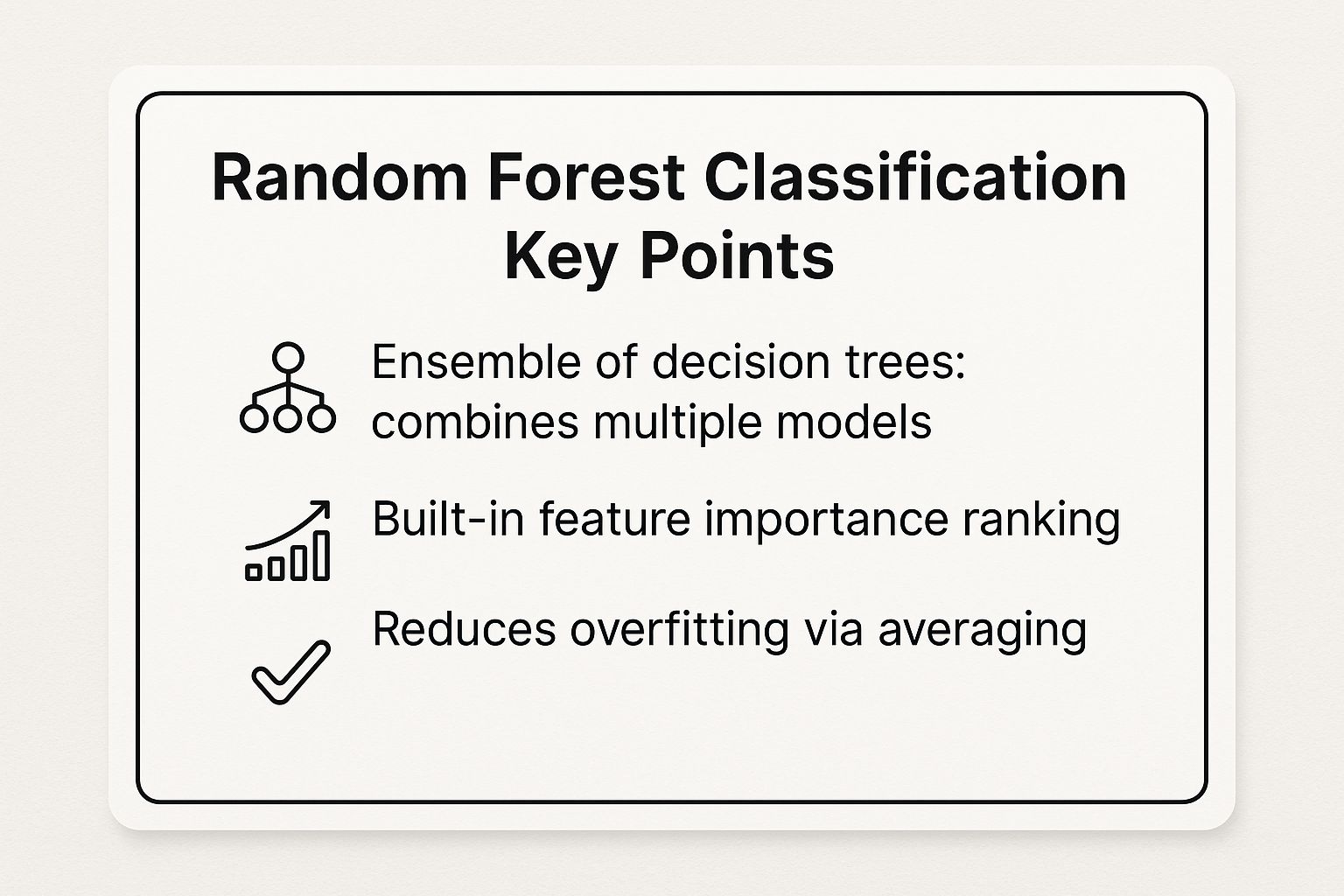
Getting started with machine learning can feel overwhelming. The theory is dense, and it's often hard to see how abstract algorithms translate into real-world results. Many aspiring practitioners and marketers face the challenge of bridging the gap between concepts and functional code. This article solves that problem by providing a curated collection of practical machine learning code examples. We move beyond theory to give you ready-to-use Python snippets that demonstrate how to solve tangible business problems, from customer segmentation to predictive modeling.
1. Linear Regression with Scikit-learn
Linear regression is a foundational supervised learning algorithm, perfect for predicting a continuous outcome like sales figures or customer lifetime value. It works by finding the best straight-line relationship between input features (e.g., ad spend) and a target variable (e.g., revenue). Its simplicity and high interpretability make it one of the most essential machine learning code examples for any marketer or developer's toolkit.
The algorithm's goal is to find the line that minimizes the distance to all data points. Python’s scikit-learn library provides a clean, powerful, and highly optimized implementation, making predictive modeling accessible to everyone.
Real-World Use Case: Predicting Ad Campaign ROI
A digital marketing agency can use linear regression to predict the return on investment (ROI) for a future ad campaign. By training a model on historical data (e.g., ad spend, impressions, clicks), they can forecast expected revenue for a given budget, helping them optimize spending and set realistic client expectations.
Actionable Takeaways & Tactical Tips
- Visualize First: Use scatter plots to visually check for a linear relationship between your variables before building the model.
- Handle Outliers: Extreme data points can skew the results. Identify and remove or adjust them to improve model accuracy.
- Scale Your Features: When features have different scales (e.g., ad spend in dollars vs. number of clicks), use scikit-learn's
StandardScalerto normalize them. This ensures the model treats all features fairly.
2. Random Forest Classification
Random Forest is a powerful ensemble method that combines multiple decision trees to make a more accurate and stable prediction. It's a go-to for classification tasks, like identifying whether a user will churn or a lead will convert. By averaging the "votes" from many trees, it avoids the common pitfall of overfitting, making it a reliable choice for complex business problems and a crucial asset in any collection of machine learning code examples.
Python's scikit-learn library offers a highly efficient and user-friendly RandomForestClassifier that has become a go-to for countless data scientists.
Real-World Use Case: Lead Scoring for Sales Teams
A startup can use a Random Forest model to score incoming leads. By training it on data from past leads (e.g., company size, job title, website interactions, source), the model can predict the likelihood of a new lead converting to a paying customer. This allows the sales team to prioritize their efforts on the most promising prospects, increasing efficiency and conversion rates.

Actionable Takeaways & Tactical Tips
- Tune
n_estimators: This parameter controls the number of trees. More trees can improve accuracy but increase computation time. Use cross-validation to find the sweet spot. - Balance Imbalanced Data: If one class is rare (e.g., fraud detection), use the
class_weight='balanced'parameter to prevent the model from being biased toward the majority class. - Analyze Feature Importance: Use the model's
feature_importances_attribute to see which factors (e.g., website page visits) are most predictive of conversion. This insight is gold for marketing strategy.
3. Neural Network with TensorFlow/Keras
Neural networks are the engine of deep learning, capable of modeling highly complex patterns in data like images and text. They are essential for tasks beyond the scope of traditional algorithms, making them one of the most powerful machine learning code examples available.
TensorFlow and Keras have made building these sophisticated models more intuitive. They are the frameworks behind many AI-powered content creation and image recognition tools.
Real-World Use Case: AI Content Categorization
A content creator or agency managing a large blog can use a neural network to automatically categorize articles. By training the model on the text of existing posts and their corresponding categories (e.g., "SEO," "Social Media," "Email Marketing"), it can learn to classify new articles instantly. This saves hours of manual work and improves website navigation and content discovery for users.
Actionable Takeaways & Tactical Tips
- Start Simple: Begin with a simple network architecture (a few layers) and gradually add complexity to avoid overfitting.
- Normalize Input Data: Neural networks train more efficiently when input data is scaled. Use
StandardScalerto normalize your features before training. - Use Callbacks: Implement
EarlyStoppingin Keras to automatically stop training when performance on new data stops improving, saving time and preventing overfitting.
4. K-Means Clustering
K-Means is a classic unsupervised learning algorithm used to discover natural groupings in data without any pre-existing labels. Its goal is to partition data into a pre-defined number (k) of clusters. This is one of the most useful machine learning code examples for exploratory analysis, helping businesses understand their audience on a deeper level.

Its simplicity and speed make it a go-to method for tasks like customer segmentation, document organization, and even image segmentation.
Real-World Use Case: Customer Segmentation for Marketers
A marketer can use K-Means to segment their customer base. By clustering customers based on data like purchase frequency, average order value, and product categories browsed, they can identify distinct personas (e.g., "high-spending loyalists," "budget-conscious shoppers," "infrequent visitors"). This allows for hyper-targeted marketing campaigns that resonate with each group, boosting engagement and ROI.
Actionable Takeaways & Tactical Tips
- Find the Right 'k': Use the "Elbow Method" to find the optimal number of clusters for your data by plotting the variance for different
kvalues. - Scale Your Features: K-Means is distance-based, so features with large scales can dominate. Always use
StandardScalerorMinMaxScalerto normalize your data first. - Visualize the Clusters: If you have two or three main features, create a scatter plot and color-code the points by cluster to visually validate the results.
👉 Try MediaWorkbench.ai for free – schedule your posts and generate AI content in one place!
5. Support Vector Machine (SVM)
Support Vector Machine (SVM) is a powerful classification algorithm that finds the optimal boundary to separate different classes. It's particularly effective in high-dimensional spaces, making it ideal for tasks like text classification or image recognition. By using the "kernel trick," SVM can even find complex, non-linear boundaries, making it one of the most versatile machine learning code examples to have in your arsenal.
Its strength lies in maximizing the "margin" or gap between classes, which often leads to high accuracy and good generalization to new data.
Real-World Use Case: Social Media Sentiment Analysis
A brand manager or social media marketer can use an SVM to classify social media mentions as positive, negative, or neutral. By training the model on a labeled dataset of tweets or comments, it can automatically analyze brand sentiment in real-time. This provides instant feedback on marketing campaigns and helps manage brand reputation proactively.
Actionable Takeaways & Tactical Tips
- Always Scale Features: SVMs are highly sensitive to feature scales. Always use
StandardScalerbefore training. - Tune
Candgamma: These hyperparameters are critical for performance. UseGridSearchCVin scikit-learn to find the best combination for your data. - Start with the RBF Kernel: For non-linear problems, the Radial Basis Function (RBF) kernel is a powerful and flexible default choice.
Conclusion
We've explored a powerful set of machine learning code examples, showing how core algorithms can be applied to solve real problems for marketers, creators, and agencies. From predicting ad campaign ROI with Linear Regression to segmenting customers with K-Means, these techniques provide the foundation for building smarter, data-driven strategies. The key takeaway is that machine learning is not just for data scientists; it's an accessible and potent tool for anyone looking to gain a competitive edge. By understanding these models, you can unlock new insights, automate repetitive tasks, and create more personalized experiences for your audience.
Ready to leverage the power of AI without writing a single line of code? MediaWorkbench.ai uses sophisticated models to help you generate, schedule, and optimize content for maximum impact. Streamline your marketing efforts and let our AI do the heavy lifting.
👉 Explore Media Workbench AI to see how our features can transform your content workflow!

